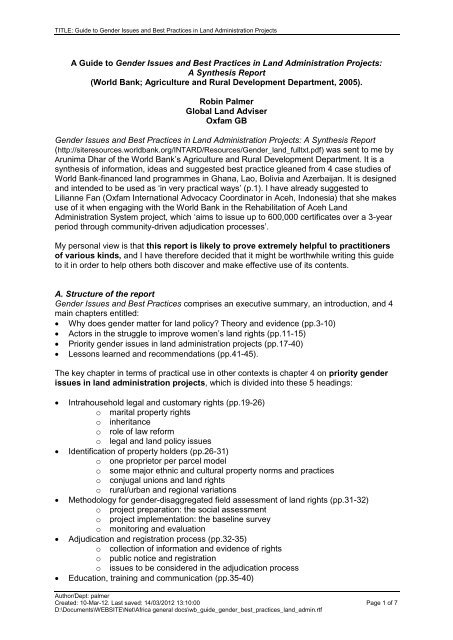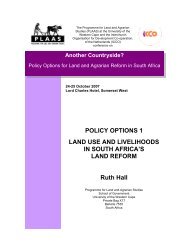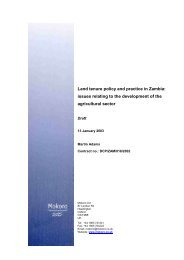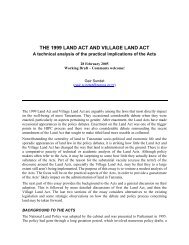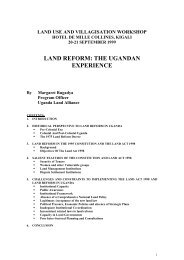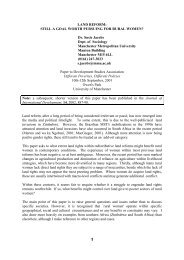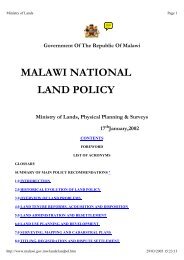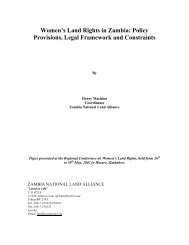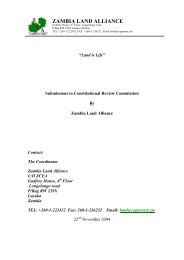Gender Issues and Best Practices in Land Administration ... - Mokoro
Gender Issues and Best Practices in Land Administration ... - Mokoro
Gender Issues and Best Practices in Land Administration ... - Mokoro
Create successful ePaper yourself
Turn your PDF publications into a flip-book with our unique Google optimized e-Paper software.
TITLE: Guide to <strong>Gender</strong> <strong>Issues</strong> <strong>and</strong> <strong>Best</strong> <strong>Practices</strong> <strong>in</strong> L<strong>and</strong> Adm<strong>in</strong>istration ProjectsA Guide to <strong>Gender</strong> <strong>Issues</strong> <strong>and</strong> <strong>Best</strong> <strong>Practices</strong> <strong>in</strong> L<strong>and</strong> Adm<strong>in</strong>istration Projects:A Synthesis Report(World Bank; Agriculture <strong>and</strong> Rural Development Department, 2005).Rob<strong>in</strong> PalmerGlobal L<strong>and</strong> AdviserOxfam GB<strong>Gender</strong> <strong>Issues</strong> <strong>and</strong> <strong>Best</strong> <strong>Practices</strong> <strong>in</strong> L<strong>and</strong> Adm<strong>in</strong>istration Projects: A Synthesis Report(http://siteresources.worldbank.org/INTARD/Resources/<strong>Gender</strong>_l<strong>and</strong>_fulltxt.pdf) was sent to me byArunima Dhar of the World Bank’s Agriculture <strong>and</strong> Rural Development Department. It is asynthesis of <strong>in</strong>formation, ideas <strong>and</strong> suggested best practice gleaned from 4 case studies ofWorld Bank-f<strong>in</strong>anced l<strong>and</strong> programmes <strong>in</strong> Ghana, Lao, Bolivia <strong>and</strong> Azerbaijan. It is designed<strong>and</strong> <strong>in</strong>tended to be used as ‘<strong>in</strong> very practical ways’ (p.1). I have already suggested toLilianne Fan (Oxfam International Advocacy Coord<strong>in</strong>ator <strong>in</strong> Aceh, Indonesia) that she makesuse of it when engag<strong>in</strong>g with the World Bank <strong>in</strong> the Rehabilitation of Aceh L<strong>and</strong>Adm<strong>in</strong>istration System project, which ‘aims to issue up to 600,000 certificates over a 3-yearperiod through community-driven adjudication processes’.My personal view is that this report is likely to prove extremely helpful to practitionersof various k<strong>in</strong>ds, <strong>and</strong> I have therefore decided that it might be worthwhile writ<strong>in</strong>g this guideto it <strong>in</strong> order to help others both discover <strong>and</strong> make effective use of its contents.A. Structure of the report<strong>Gender</strong> <strong>Issues</strong> <strong>and</strong> <strong>Best</strong> <strong>Practices</strong> comprises an executive summary, an <strong>in</strong>troduction, <strong>and</strong> 4ma<strong>in</strong> chapters entitled: Why does gender matter for l<strong>and</strong> policy? Theory <strong>and</strong> evidence (pp.3-10) Actors <strong>in</strong> the struggle to improve women’s l<strong>and</strong> rights (pp.11-15) Priority gender issues <strong>in</strong> l<strong>and</strong> adm<strong>in</strong>istration projects (pp.17-40) Lessons learned <strong>and</strong> recommendations (pp.41-45).The key chapter <strong>in</strong> terms of practical use <strong>in</strong> other contexts is chapter 4 on priority genderissues <strong>in</strong> l<strong>and</strong> adm<strong>in</strong>istration projects, which is divided <strong>in</strong>to these 5 head<strong>in</strong>gs:Intrahousehold legal <strong>and</strong> customary rights (pp.19-26)o marital property rightso <strong>in</strong>heritanceo role of law reformo legal <strong>and</strong> l<strong>and</strong> policy issuesIdentification of property holders (pp.26-31)o one proprietor per parcel modelo some major ethnic <strong>and</strong> cultural property norms <strong>and</strong> practiceso conjugal unions <strong>and</strong> l<strong>and</strong> rightso rural/urban <strong>and</strong> regional variationsMethodology for gender-disaggregated field assessment of l<strong>and</strong> rights (pp.31-32)o project preparation: the social assessmento project implementation: the basel<strong>in</strong>e surveyo monitor<strong>in</strong>g <strong>and</strong> evaluationAdjudication <strong>and</strong> registration process (pp.32-35)o collection of <strong>in</strong>formation <strong>and</strong> evidence of rightso public notice <strong>and</strong> registrationo issues to be considered <strong>in</strong> the adjudication processEducation, tra<strong>in</strong><strong>in</strong>g <strong>and</strong> communication (pp.35-40)Author/Dept: palmerCreated: 10-Mar-12. Last saved: 14/03/2012 13:10:00 Page 1 of 7D:\Documents\WEBSITE\Net\Africa general docs\wb_guide_gender_best_practices_l<strong>and</strong>_adm<strong>in</strong>.rtf
TITLE: Guide to <strong>Gender</strong> <strong>Issues</strong> <strong>and</strong> <strong>Best</strong> <strong>Practices</strong> <strong>in</strong> L<strong>and</strong> Adm<strong>in</strong>istration Projectsoootra<strong>in</strong><strong>in</strong>g of implementerstra<strong>in</strong><strong>in</strong>g of <strong>and</strong> communication with beneficiariesother considerationsThe f<strong>in</strong>al chapter (5) conta<strong>in</strong>s a series of lessons learned <strong>and</strong> recommendations (pp.41-45)under these categories: Legal foundation Identification of property rights holders Research Adjudication <strong>and</strong> registration processes Education, tra<strong>in</strong><strong>in</strong>g <strong>and</strong> communication Recommendations for project designers <strong>and</strong> implementers Recommendations for project beneficiaries.They draw together issues discussed <strong>in</strong> the earlier chapters <strong>and</strong> provide some excellentcheck lists for people <strong>in</strong>volved <strong>in</strong> project plann<strong>in</strong>g <strong>and</strong> implementation, <strong>in</strong>clud<strong>in</strong>g<strong>in</strong>volv<strong>in</strong>g both women <strong>and</strong> men as role models <strong>and</strong> mentors, us<strong>in</strong>g local expertise,respect<strong>in</strong>g local variations <strong>and</strong> the need for basel<strong>in</strong>e data.The chapters are followed by 5 appendices:1. Summaries of country case studies (Azerbaijan, Bolivia, Ghana, Lao) (pp.47-54)2. Case study methodologies (pp.55-56)3. Sample template for gender-specific social assessment (pp.57-58)4. Sample gender-specific <strong>in</strong>dicators for monitor<strong>in</strong>g <strong>and</strong> evaluation of World Bank l<strong>and</strong>adm<strong>in</strong>istration projects (p.59)5. Sample questionnaire for data collection for basel<strong>in</strong>e <strong>and</strong> impact evaluation (pp.59-81)Appendix 5 is divided <strong>in</strong>to 9 modules (pp.60-81) which are designed to be adapted <strong>and</strong>modified as needed. The modules are: household roster, parcel <strong>in</strong>formation, wealth, credit, community participation, nonfarm employment, household enterprise, expenditure (food <strong>and</strong> non-food), community-level data (demography <strong>and</strong> l<strong>and</strong> use, services <strong>and</strong> <strong>in</strong>frastructure,employment <strong>and</strong> migration, agriculture, community organizations, credit).I feel it is worth lay<strong>in</strong>g out the structure of the report <strong>in</strong> this level of detail <strong>in</strong> order to givepotential readers a clear picture of its coverage. As <strong>in</strong>dicated earlier, I believe that theauthors have succeeded <strong>in</strong> mak<strong>in</strong>g this an extremely useful <strong>and</strong> practical guide, full ofquestions that need to be raised, helpful checklists, a matrix on different forms of propertyownership (p.20), <strong>and</strong> the valuable Appendix 5 - sample questionnaire for data collection forbasel<strong>in</strong>e <strong>and</strong> impact evaluation (pp.59-81).In what follows, I have gathered together some of the report’s contents <strong>and</strong> conclusions,spr<strong>in</strong>kled with a few comments of my own, under the follow<strong>in</strong>g 8 head<strong>in</strong>gs:1. The need for gender-disaggregated <strong>in</strong>formation2. Acknowledg<strong>in</strong>g regional differences3. Trust<strong>in</strong>g the customary?4. <strong>Gender</strong> dimensions <strong>in</strong> l<strong>and</strong> adm<strong>in</strong>istration5. Cultural constra<strong>in</strong>ts6. The power of regulations7. Adjudication8. Know<strong>in</strong>g your rights, education <strong>and</strong> tra<strong>in</strong><strong>in</strong>g.B. Some key issues raised <strong>in</strong> the reportAuthor/Dept: palmerCreated: 10-Mar-12. Last saved: 14/03/2012 13:10:00 Page 2 of 7D:\Documents\WEBSITE\Net\Africa general docs\wb_guide_gender_best_practices_l<strong>and</strong>_adm<strong>in</strong>.rtf
TITLE: Guide to <strong>Gender</strong> <strong>Issues</strong> <strong>and</strong> <strong>Best</strong> <strong>Practices</strong> <strong>in</strong> L<strong>and</strong> Adm<strong>in</strong>istration Projects1.The need for gender-disaggregated <strong>in</strong>formationPerhaps the most important sentence <strong>in</strong> the whole report is this one:‘Make gender an <strong>in</strong>tegral part of the [l<strong>and</strong> adm<strong>in</strong>istration] project from the beg<strong>in</strong>n<strong>in</strong>g<strong>and</strong> <strong>in</strong> all of its phases <strong>and</strong> components.’ (p.xi).The report argues strongly for the need to gather gender-disaggregated <strong>in</strong>formation, notleast, one suspects, because ‘gender was not considered explicitly at the time of projectdesign’ <strong>in</strong> 3 of the 4 countries from which the report’s f<strong>in</strong>d<strong>in</strong>gs have been drawn. (p.x)Indeed, the report states that ‘few, if any, projects gather gender-disaggregated <strong>in</strong>formationat the beg<strong>in</strong>n<strong>in</strong>g of a project <strong>and</strong> throughout its life.’ (p.12). Therefore, at the time of projectpreparation, ‘gender-specific <strong>in</strong>dicators should be developed to measure the program’sdifferential impact on men’s <strong>and</strong> women’s l<strong>and</strong> rights’ (p.31) because ‘explicitly recogniz<strong>in</strong>ggender as an issue to be considered at the outset will allow better monitor<strong>in</strong>g <strong>and</strong> evaluationof project impacts <strong>and</strong> will enable the required f<strong>in</strong>ancial costs <strong>and</strong> the required expertise forprograms to be <strong>in</strong>cluded.’ (p.19) ‘Underst<strong>and</strong><strong>in</strong>g gender differences requires gather<strong>in</strong>ghousehold-level <strong>in</strong>formation at the earliest stages of the project.’ (p.x). Appendix 3 (pp.57-58)‘provides a template for key <strong>in</strong>formant <strong>in</strong>terview <strong>and</strong> focus-group protocols that could serveas a guidel<strong>in</strong>e for future l<strong>and</strong> project social assessments’ (p.31).The report argues that ‘the collection of appropriate gender-specific data is a concern for alll<strong>and</strong> adm<strong>in</strong>istration projects <strong>and</strong> should be a World Bank priority, given its <strong>in</strong>vestments <strong>in</strong> thel<strong>and</strong> sector. The knowledge regard<strong>in</strong>g gender <strong>and</strong> l<strong>and</strong> rights consists of (1) how l<strong>and</strong> rightsare distributed among different groups of women <strong>and</strong> men, <strong>and</strong> (2) what effectsdifferentiated l<strong>and</strong> rights have on gender equity <strong>and</strong> on women’s capabilities. Collection ofthis <strong>in</strong>formation should be done dur<strong>in</strong>g l<strong>and</strong> adm<strong>in</strong>istration project preparation to guidedesign of the project, dur<strong>in</strong>g project implementation, <strong>and</strong> after the project is completed. Themethods for collect<strong>in</strong>g these data <strong>in</strong>clude social assessments, base-l<strong>in</strong>e studies, <strong>and</strong> impactevaluationstudies. The importance of collect<strong>in</strong>g gender-disaggregated data is essentialfor assess<strong>in</strong>g the extent <strong>and</strong> depth of women’s l<strong>and</strong> rights <strong>and</strong> for assess<strong>in</strong>g theimpact of l<strong>and</strong> adm<strong>in</strong>istration projects on gender equity.’ (p.31)In particular, without good basel<strong>in</strong>e data it is difficult: to know what are the gender-related issues that need to be addressed to measure the gendered effects of the project at a later date to raise awareness of the need for gender-disaggregated data (p.43).2. Acknowledg<strong>in</strong>g regional differences‘Dur<strong>in</strong>g design <strong>and</strong> implementation of adjudication processes <strong>and</strong> registrationsystems, project staff need to be aware of the complexity of tenure <strong>and</strong> the variety oflocal customs <strong>and</strong> practices that can exist with<strong>in</strong> a country.‘ (p.xi).There is a useful <strong>in</strong>troductory section outl<strong>in</strong><strong>in</strong>g different patterns <strong>and</strong> trends <strong>in</strong> l<strong>and</strong> tenureregimes, legal structures <strong>and</strong> household resource allocation <strong>in</strong> Africa, Asia, Central <strong>and</strong>Eastern Europe <strong>and</strong> the former Soviet Union, <strong>and</strong> Lat<strong>in</strong> America (pp.5-10).As an example, <strong>in</strong> Africa ‘the rights of African women regard<strong>in</strong>g l<strong>and</strong> ownership <strong>and</strong>management vary dramatically accord<strong>in</strong>g to the cultural <strong>and</strong> historical context of the regionthey marry <strong>in</strong>to’ (p.5), with Muslim societies <strong>and</strong> matril<strong>in</strong>eal areas offer<strong>in</strong>g women greatestopportunities (pp.5-6). The authors warn that ‘customary rights of women for seasonal orother shared use of l<strong>and</strong> can be cut off by <strong>in</strong>dividualization of ownership rights. Ifthese “secondary” rights are not specifically preserved (for <strong>in</strong>stance, by register<strong>in</strong>gAuthor/Dept: palmerCreated: 10-Mar-12. Last saved: 14/03/2012 13:10:00 Page 3 of 7D:\Documents\WEBSITE\Net\Africa general docs\wb_guide_gender_best_practices_l<strong>and</strong>_adm<strong>in</strong>.rtf
TITLE: Guide to <strong>Gender</strong> <strong>Issues</strong> <strong>and</strong> <strong>Best</strong> <strong>Practices</strong> <strong>in</strong> L<strong>and</strong> Adm<strong>in</strong>istration Projectsthem), they can be lost.’ (p.6). Women may also lose rights to l<strong>and</strong>, even <strong>in</strong> communalsystems, when l<strong>and</strong> becomes more valuable. They cite Kaori Izumi as show<strong>in</strong>g how <strong>in</strong>Tanzania ‘widowed women who had previously been allowed to stay on their husb<strong>and</strong>s’ l<strong>and</strong>are now be<strong>in</strong>g dispossessed of that l<strong>and</strong> as it <strong>in</strong>creases <strong>in</strong> value’ (pp.6-7).3. Trust<strong>in</strong>g the customary?The report argues generally that ‘Customary <strong>in</strong>stitutions are often very important forenforc<strong>in</strong>g women’s l<strong>and</strong> rights or mak<strong>in</strong>g changes to long-held customary norms. They arelocal <strong>and</strong> therefore accessible, the leaders are generally respected by the community, <strong>and</strong>women are less ashamed to approach village leaders than to participate <strong>in</strong> a formal courthear<strong>in</strong>g.’ (p.13). Moreover ‘these traditional <strong>in</strong>stitutions can have more power to changecultural norms than do legislative bodies or modern <strong>in</strong>stitutions. Traditional leaders are ableto speak with authority for the whole community <strong>and</strong> can thereby <strong>in</strong>stitute fundamental,socially agreed change’ (p.14).This may well be true <strong>in</strong> many cases, but not of course <strong>in</strong> all, as the fierce debates <strong>in</strong> SouthAfrica around the Communal L<strong>and</strong> Rights Act testify, while, as Ann Whitehead <strong>and</strong> DzodziTsikata have po<strong>in</strong>ted out, 1 African women lawyers are much more equivocal about trust<strong>in</strong>gthe customary, preferr<strong>in</strong>g to look to the State for laws to protect women’s <strong>in</strong>terests. Theyargue that there are considerable problems with so-called customary systems of l<strong>and</strong> tenure<strong>and</strong> adm<strong>in</strong>istration for achiev<strong>in</strong>g gender justice with respect to women's l<strong>and</strong> claims <strong>in</strong> Africa<strong>and</strong> that <strong>in</strong>sufficient attention is be<strong>in</strong>g paid to power relations <strong>in</strong> the countryside <strong>and</strong> theirimplications for social groups, such as women, who are not well positioned <strong>and</strong> represented<strong>in</strong> local level power structures.4. <strong>Gender</strong> dimensions <strong>in</strong> l<strong>and</strong> adm<strong>in</strong>istration‘<strong>Issues</strong> <strong>in</strong> l<strong>and</strong> adm<strong>in</strong>istration reforms that have a gender dimension <strong>in</strong>clude:1. a lack of underst<strong>and</strong><strong>in</strong>g of the complexity <strong>and</strong> diversity of l<strong>and</strong> tenure patterns,<strong>in</strong>clud<strong>in</strong>g women’s rights, by most l<strong>and</strong> adm<strong>in</strong>istrators, by project managers, <strong>and</strong> bythose provid<strong>in</strong>g technical assistance;2. a belief that address<strong>in</strong>g gender issues only means issu<strong>in</strong>g titles or co-titles to women,with little appreciation, for <strong>in</strong>stance, for what happens (a) <strong>in</strong> subsequent transactions, (b)<strong>in</strong> enforcement <strong>and</strong> actualization of those rights, (c) <strong>in</strong> realiz<strong>in</strong>g the benefits that maystem from formaliz<strong>in</strong>g women’s rights (such as access to credit), <strong>and</strong> (d) <strong>in</strong> alter<strong>in</strong>gdecision-mak<strong>in</strong>g powers with<strong>in</strong> households;3. a belief that address<strong>in</strong>g gender issues with<strong>in</strong> l<strong>and</strong> adm<strong>in</strong>istration is ensur<strong>in</strong>g that womenare hired (for example, as clerks, <strong>in</strong>terpreters, social specialists), rather thanma<strong>in</strong>stream<strong>in</strong>g equal opportunities for all employees <strong>in</strong> all types of activities.’ (p.18)Important questions lead<strong>in</strong>g to a better underst<strong>and</strong><strong>in</strong>g of how best to identify <strong>and</strong> formalizewomen’s l<strong>and</strong> rights <strong>in</strong>clude: ‘Who has communal <strong>and</strong> who has <strong>in</strong>dividual rights to l<strong>and</strong>? What are the <strong>in</strong>heritance <strong>and</strong> marriage practices? How much of a role do consensual unions that are not formalized play with<strong>in</strong> the socialsystem? What are the variations between urban <strong>and</strong> rural areas?’ (pp.x-xi).1 Ann Whitehead <strong>and</strong> Dzodzi Tsikata, ‘Policy Discourses on Women’s L<strong>and</strong> Rights <strong>in</strong> Sub-Saharan Africa: TheImplications of the Re-turn to the Customary’, Journal of Agrarian Change, vol. 3, nos.1 <strong>and</strong> 2, January <strong>and</strong> April,2003, 67-112. http://www.oxfam.org.uk/resources/learn<strong>in</strong>g/l<strong>and</strong>rights/downloads/return.rtfAuthor/Dept: palmerCreated: 10-Mar-12. Last saved: 14/03/2012 13:10:00 Page 4 of 7D:\Documents\WEBSITE\Net\Africa general docs\wb_guide_gender_best_practices_l<strong>and</strong>_adm<strong>in</strong>.rtf
TITLE: Guide to <strong>Gender</strong> <strong>Issues</strong> <strong>and</strong> <strong>Best</strong> <strong>Practices</strong> <strong>in</strong> L<strong>and</strong> Adm<strong>in</strong>istration Projects‘There has been recognition that the practice of issu<strong>in</strong>g titles to just one person <strong>in</strong> thehousehold (the household head) may be deny<strong>in</strong>g other people their l<strong>and</strong> rights. Morethan one person may hold rights to a particular parcel of l<strong>and</strong>. Or, if there is more than oneparcel, different people may have rights to different parcels.’ But ‘titl<strong>in</strong>g brigades are nottra<strong>in</strong>ed to look for <strong>and</strong> identify more than one property rights holder.’ (p.27).The report warns that <strong>in</strong> legislation gender-neutral terms such as head of household may notbe <strong>in</strong>terpreted neutrally, <strong>and</strong> therefore ‘at a m<strong>in</strong>imum it must explicitly recognize women’s<strong>and</strong> men’s equal rights to l<strong>and</strong>’ as happened <strong>in</strong> Bolivia (p.26).5. Cultural constra<strong>in</strong>tsThe lack of underst<strong>and</strong><strong>in</strong>g mentioned above is well illustrated <strong>in</strong> the case of a Peruvian ruraltitl<strong>in</strong>g programme, which ‘did not consider the cultural constra<strong>in</strong>ts that women, particularlyrural women, may face <strong>in</strong> hav<strong>in</strong>g their names <strong>in</strong>cluded on l<strong>and</strong> titles. In addition, titl<strong>in</strong>gprogram officers did not receive any gender-sensitivity tra<strong>in</strong><strong>in</strong>g at the m<strong>in</strong>isterial <strong>and</strong> programlevels or at the ground implementation level.’ (p.14).The section on <strong>in</strong>trahousehold legal <strong>and</strong> customary rights lists some of the questions thatpolicy makers <strong>and</strong> project managers need to ask about formal <strong>and</strong> <strong>in</strong>formal rights to l<strong>and</strong> for<strong>in</strong>dividuals <strong>and</strong> households <strong>and</strong> with<strong>in</strong> households <strong>and</strong> communities. It notes that ‘culturalprohibitions aga<strong>in</strong>st women’s ownership or use of l<strong>and</strong> are often more powerful than writtenlaw’ <strong>and</strong> that ‘l<strong>and</strong> projects generally must deal with formal law <strong>and</strong> customs related to<strong>in</strong>trahousehold property as they exist, <strong>and</strong> they must work with<strong>in</strong> them. Much can be donewith<strong>in</strong> l<strong>and</strong> legislation’ but family, <strong>in</strong>heritance or customary law ‘may have a more significanteffect on women. Although chang<strong>in</strong>g family law <strong>and</strong> <strong>in</strong>heritance law may be necessary, suchchanges do not come easily <strong>and</strong> <strong>in</strong> some cases would be outside the realm of a l<strong>and</strong>adm<strong>in</strong>istration project.’ (p.19). One th<strong>in</strong>ks here of communities ravaged by HIV/AIDS <strong>and</strong> thestruggles to change ‘customs’ which have become <strong>in</strong>imical to women’s lives <strong>and</strong> livelihoods.‘Policies related to <strong>in</strong>trahousehold transfers of l<strong>and</strong>, such as <strong>in</strong>heritance <strong>and</strong> marital property,need to be studied <strong>and</strong> understood before advis<strong>in</strong>g on l<strong>and</strong>-related legislation. Inheritance<strong>and</strong> marital property rules <strong>and</strong> practices have a major impact on women’s rights toownership of l<strong>and</strong> <strong>and</strong> their poverty status’ (pp.25-26).The report argues that ‘two legal issues related to community property must be exam<strong>in</strong>ed <strong>in</strong>the context of l<strong>and</strong> adm<strong>in</strong>istration <strong>and</strong> titl<strong>in</strong>g: consensual unions <strong>and</strong> polygamy. Legalmarriage can be expensive <strong>and</strong> time consum<strong>in</strong>g, <strong>and</strong> it may require residence or personalidentification that women do not have’ (p.24). In Bolivia <strong>and</strong> Lao ‘a specific legal provisionthat a consensual union will trigger legal protection of property rights acquired dur<strong>in</strong>g thatunion would enable many unmarried women to enforce their property rights when they wouldnot otherwise be able to do’ (p.24). Polygamy ‘seriously affects women’s rights to property<strong>and</strong> is the source of much tension <strong>and</strong> anxiety over l<strong>and</strong> rights <strong>in</strong> many countries. Legislationaround polygamy is difficult, but to ignore formal or <strong>in</strong>formal polygamy is to <strong>in</strong>adequatelyprotect women’s property rights. There are no effective <strong>and</strong> gender-sensitive titl<strong>in</strong>gprocedures for polygamous households’ (p.30).6. The power of regulationsThe report argues that ‘the biggest impact on women are more often found <strong>in</strong> the regulations<strong>and</strong> not the broader policy statements of the law.’ (p.26). Therefore, among the issues thatshould be considered (this is not the full list) are:Are men <strong>and</strong> women guaranteed equal participation <strong>in</strong> the adjudication process?Author/Dept: palmerCreated: 10-Mar-12. Last saved: 14/03/2012 13:10:00 Page 5 of 7D:\Documents\WEBSITE\Net\Africa general docs\wb_guide_gender_best_practices_l<strong>and</strong>_adm<strong>in</strong>.rtf
TITLE: Guide to <strong>Gender</strong> <strong>Issues</strong> <strong>and</strong> <strong>Best</strong> <strong>Practices</strong> <strong>in</strong> L<strong>and</strong> Adm<strong>in</strong>istration ProjectsIs the director of the l<strong>and</strong> agency held responsible for nondiscrim<strong>in</strong>atory practices withregard to gender?What documents are required by the regulations for proof of ownership? Are thesedocuments readily available to both men <strong>and</strong> women, <strong>and</strong> are they expensive to acquire?Do the regulations require proof of marriage or consensual union? What type of proof isrequired?Do the regulations require written consent for transfer of property held <strong>in</strong> commonownership? Are there guidel<strong>in</strong>es for how to determ<strong>in</strong>e whether l<strong>and</strong> is held <strong>in</strong> commonownership by operation of law, even if it is registered <strong>in</strong> only one name?Do the regulations deal with polygamy if necessary?Do the regulations deal with illiteracy?Where are disputes adjudicated?How do the issues of money, time <strong>and</strong> literacy <strong>in</strong>fluence the dispute resolution process?(p.26)7. AdjudicationOn adjudication, these are some of the questions that need to be considered to protect the<strong>in</strong>terests of women <strong>and</strong> men:1. Have all of the stakeholders had access to <strong>in</strong>formation concern<strong>in</strong>g their rights <strong>and</strong> theadjudication process?2. Is the adjudication team familiar with the local customs, laws, <strong>and</strong> practices affect<strong>in</strong>g therights of both men <strong>and</strong> women?3. Do the processes have to be modified from region to region (for example, urban/rural orother types of l<strong>and</strong> tenure?4. Are secondary <strong>in</strong>terests, <strong>in</strong>clud<strong>in</strong>g rights to resources, considered <strong>and</strong> protected <strong>in</strong> someway through the adjudication?5. Do all stakeholders have equal access to the documentation required for adjudication,<strong>and</strong>, if not, what measures can be taken to level the play<strong>in</strong>g field?6. Are the tim<strong>in</strong>g <strong>and</strong> location of adjudication procedures <strong>and</strong> registration officesappropriate for all potential <strong>in</strong>terest holders.7. Are women’s rights adequately represented <strong>and</strong> protected <strong>in</strong> dispute resolution <strong>and</strong> howcan lengthy <strong>and</strong> costly litigation be avoided? (pp.34-35).8. Know<strong>in</strong>g your rights, education <strong>and</strong> tra<strong>in</strong><strong>in</strong>gThe report makes the valid po<strong>in</strong>t that ‘legislative reform by itself often makes little differenceto the majority of women’ <strong>and</strong> that those who take advantage tend to be ‘urban, educated,<strong>and</strong> usually wealthy women.’ (p.25). But law can create open<strong>in</strong>gs for women’s l<strong>and</strong> rights.Hence the trend is to avoid hav<strong>in</strong>g disputes reach the courts, partly because of cost <strong>and</strong>partly because ‘disputants, particularly women, often have unequal powers to acquire legaladvice <strong>and</strong> to susta<strong>in</strong> their claims.’ (p.34)‘The most important aspect of the provision of public notice is that all potentialstakeholders have the ability to know about <strong>and</strong> underst<strong>and</strong> their rights <strong>and</strong> anythreat to those rights. Thus, issues such as media, illiteracy (<strong>in</strong>clud<strong>in</strong>g map illiteracy),location, <strong>and</strong> tim<strong>in</strong>g are crucial. Public displays need to be accessible to everyone, <strong>in</strong>clud<strong>in</strong>gthe elderly <strong>and</strong> those who cannot leave home because of cost, lack of transportation, orhousehold responsibilities. Whereas this affects both women <strong>and</strong> men, women <strong>in</strong> rural areasare often less mobile than men.’ (p.33)Author/Dept: palmerCreated: 10-Mar-12. Last saved: 14/03/2012 13:10:00 Page 6 of 7D:\Documents\WEBSITE\Net\Africa general docs\wb_guide_gender_best_practices_l<strong>and</strong>_adm<strong>in</strong>.rtf
TITLE: Guide to <strong>Gender</strong> <strong>Issues</strong> <strong>and</strong> <strong>Best</strong> <strong>Practices</strong> <strong>in</strong> L<strong>and</strong> Adm<strong>in</strong>istration ProjectsThe Cambodian case‘An example of successful <strong>in</strong>formation campaigns that <strong>in</strong>clude gender issues at the locallevel is the case of Cambodia’s l<strong>and</strong> titl<strong>in</strong>g project. This education activity <strong>in</strong>cludes both men<strong>and</strong> women <strong>and</strong> is careful to ensure that illiterate women are provided with appropriate<strong>in</strong>formation. All related materials are posted <strong>in</strong> a public place <strong>in</strong> the villages, literature onl<strong>and</strong> rights <strong>and</strong> titl<strong>in</strong>g procedures is provided <strong>in</strong> pictorial form, meet<strong>in</strong>gs are held <strong>in</strong> localschools or community centers, <strong>and</strong> titles are issued locally. Involvement of both female <strong>and</strong>male field staff helps emphasize gender <strong>in</strong>clusiveness.’ (p.38)‘The tra<strong>in</strong><strong>in</strong>g of implementers <strong>and</strong> communication with beneficiaries are key tounderst<strong>and</strong><strong>in</strong>g gender equity <strong>in</strong> any l<strong>and</strong> adm<strong>in</strong>istration project.’ (p.xi).Education, tra<strong>in</strong><strong>in</strong>g <strong>and</strong> communication, the report suggests, are valuable – I would arguevital - tools <strong>in</strong>: promot<strong>in</strong>g gender equity <strong>in</strong> l<strong>and</strong> adm<strong>in</strong>istration rais<strong>in</strong>g awareness about rights with<strong>in</strong> a country <strong>and</strong> hence encourag<strong>in</strong>g longerterm susta<strong>in</strong>ability mak<strong>in</strong>g project implementers more aware of social <strong>and</strong> cultural implications <strong>and</strong> the needfor gender sensitivity <strong>in</strong>creas<strong>in</strong>g the participation of women <strong>in</strong> l<strong>and</strong> adm<strong>in</strong>istration, classically a maledom<strong>in</strong>atedprofession <strong>in</strong>creas<strong>in</strong>g the participation of women <strong>and</strong> men <strong>in</strong> titl<strong>in</strong>g <strong>and</strong> registration processes(p.35).‘An important opportunity exists for World Bank <strong>in</strong>tervention by <strong>in</strong>clud<strong>in</strong>g women <strong>in</strong> anytechnical or other tra<strong>in</strong><strong>in</strong>g, education programs, or study tours. This has been shownto be an enabl<strong>in</strong>g strategy that can promote more gender <strong>in</strong>clusion, despite thetraditions with<strong>in</strong> l<strong>and</strong> adm<strong>in</strong>istration. It enables women to play more than a secondaryrole, <strong>and</strong> it encourages project managers to be more aware of gender balance.’ (p.36).Moreover, ‘It is always important to <strong>in</strong>clude both men <strong>and</strong> women <strong>in</strong> tra<strong>in</strong><strong>in</strong>g to prevent themarg<strong>in</strong>alization of gender issues to female staff.’ (p.37)‘Inform<strong>in</strong>g both men <strong>and</strong> women of their rights is essential for mutual underst<strong>and</strong><strong>in</strong>g of anydifferences. Sessions with both men <strong>and</strong> women also allow each group to underst<strong>and</strong>potential barriers to full participation (for example, schedul<strong>in</strong>g of adjudication, travel<strong>in</strong>g toregistry offices, obta<strong>in</strong><strong>in</strong>g documentation), <strong>and</strong> may encourage households to overcomethese barriers together. However, it is also often important to hold separate sessions forwomen to provide a non-threaten<strong>in</strong>g environment for discussion <strong>and</strong> to provide feedback tothe l<strong>and</strong> adm<strong>in</strong>istration processes. Hav<strong>in</strong>g public meet<strong>in</strong>gs <strong>in</strong> which younger people canparticipate is also a way to ensure that the next generation of l<strong>and</strong>holders is also a way toensure that the next generation of l<strong>and</strong>holders better underst<strong>and</strong>s its rights.’ (p.39)9, A f<strong>in</strong>al brief caveatWhile ‘m<strong>in</strong>dful of the potentially negative consequences of exclud<strong>in</strong>g women from l<strong>and</strong>programs, the formalization of women’s property rights <strong>in</strong> l<strong>and</strong> should not <strong>in</strong> <strong>and</strong> itself beseen as a panacea for gender <strong>in</strong>equality – just as l<strong>and</strong> market reform <strong>in</strong> general is not apanacea for poverty.’ (p.5).Author/Dept: palmerCreated: 10-Mar-12. Last saved: 14/03/2012 13:10:00 Page 7 of 7D:\Documents\WEBSITE\Net\Africa general docs\wb_guide_gender_best_practices_l<strong>and</strong>_adm<strong>in</strong>.rtf


